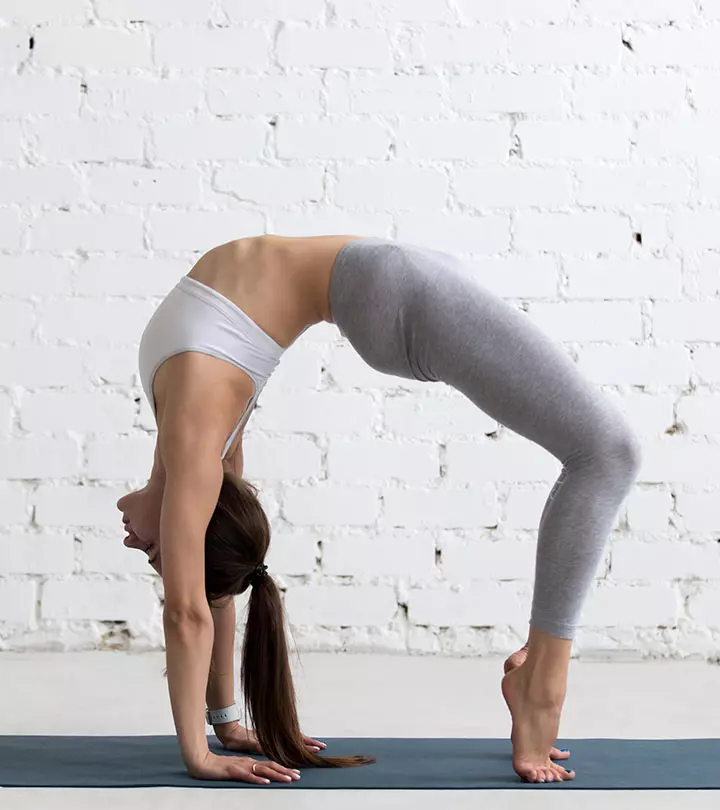77 Internal, External, And Emotional Health Benefits Of Yoga
Center your thoughts and boost your body's flexibility and balance effortlessly.

Image: shutter stock
The popularity of yoga has risen substantially in recent times, partly due to its focus on mindfulness. Research also backs the benefits of yoga. Not only that, many medical professionals and celebrities have adopted and are promoting it for its numerous health benefits. While some people think of yoga as a temporary fad combined with new age mysticism, others swear by its health benefits. What many people do not realize is that while yoga may seem like just another form of exercise, it can actually benefit them in unforeseen ways. Learn more about the benefits of yoga below. Scroll down!
Before diving into the benefits, let’s take a look at a recent survey that studied the growing number of yoga participants in the US each year. Starting from 2010 to 2025, a gradual increase can be seen in the graph below, indicating that more individuals in the US took part in yoga with an increase of 63.8 percent between the first and last year of the survey.

Representation Of Yoga Participants In The United States
Source: StatistaIn This Article
An Insight Into The World Of Yoga
A. What Is Yoga?

Before we get into the benefits of yoga, it is important to understand what yoga really is. Many people call it an ancient method of training, and others call it a set of difficult poses. But the word ‘yoga’ actually means union. It is a practice that connects the body, mind, and spirit through different body postures, meditation, and controlled breathing.
A 2025 survey done by the The Global Yoga Survey shared responses from 10,982 participants about the top benefits of yoga according to the masses. The results indicated that respondents believed the different benefits of yoga included flexibility (85.9% votes), strength (79.9% votes), balance (71.1%), chronic pain relief (34.4%), and weight loss (29.4% votes).

The renowned Yogi, Sadhguru Jaggi Vasudev calls yoga “an expression of life.” He says, “Yoga essentially means finding the keys to the nature of the existence.”
Yoga is not just about bending or twisting the body and holding the breath. It is a mechanism to bring you into a state where you see and experience reality just the way it is. If you allow your energies to become exuberant and ecstatic, your sensory body expands. This enables you to experience the whole universe as a part of yourself, making everything one – this is the union that yoga creates.
The founder of Yoga, Patanjali said, “Sthiram sukham asanam.” It means that a posture that seems firm and comfortable is your asana. You might be surprised to know that an asana is only a preparatory step in the practice of yoga. It is a means that helps you achieve the greater good. Yoga aims to create perfect harmony between your mind, body, and spirit. When you fine-tune yourself so that everything functions wonderfully within you, you will bring out the best of your abilities.
 Trivia
TriviaThe perfect unison can be achieved through Hatha Yoga and its various branches (Ashtanga Yoga, Iyengar Yoga, Bikram Yoga, Yin Yoga, Kundalini Yoga), depending on what you like and the problems you are looking to tackle through the practice.
B. Types Of Yoga
There are diverse forms of yoga that cater to the requirements of different individuals. Learn more about them below.
- Hatha Yoga: It combines postures and breathing exercises to promote balance and flexibility. The benefits of Hatha yoga asanas also extend to enhancing mental calmness and physical strength.
- Vinyasa Yoga: It focuses on flow and seamlessly transitions from one pose to another to help enhance strength and coordination.
- Restorative Yoga: It is a great option for those seeking deep relaxation and stress relief. It involves gentle poses and mindful breathing.
- Bikram Yoga: It is conducted in a heated room and aims to detoxify the body while enhancing flexibility.
- Ashtanga Yoga: It follows a set sequence of postures and fosters discipline and endurance.
- Kundalini Yoga: It incorporates dynamic breathing techniques and meditation to awaken spiritual energy.
Continue reading to learn more about the many benefits of these yoga poses on your overall well-being.
C. What Are The Benefits Of Yoga?

Yoga as a practice has countless benefits that positively affect you both physically and mentally. The picture above gives you an overview of how yoga affects your body over a span of time. Mentioned below are the different ways yoga helps you overcome health and wellness issues. There are about 77 benefits listed. Take a look.
D. The Internal Health Benefits Of Yoga
Whether it is reducing your blood pressure or raising your pain tolerance, listed below are a few things that yoga works on internally. These are some positive changes you will feel within a few days of practice.

- Enhanced Circulation – The very first thing that yoga does is improve the circulation of blood. This means better transportation of oxygen and nutrients throughout the body. Improved blood flow also indicates healthier organs and glowing skin.
- Lowered Blood Pressure – When you practice yoga regularly, the blood circulation in the body is enhanced. This also allows oxygenation in the body. There is a significant reduction in blood pressure as the body calms down.
- A Drop in The Pulse Rate – Yoga reduces the strain in the body, thereby easing it down. When the body relaxes, the pulse rate is lowered. A low pulse rate indicates that your heart is strong enough to pump more blood in a span of fewer beats.
- Lowered Respiratory Rate – Yoga involves a whole lot of controlled breathing. It entails filling your lungs to their full capacity, thus allowing them to work more efficiently.
- Better Cardiovascular Endurance – Yoga improves oxygenation in the body and also lowers the heart rate. This results in higher cardiovascular endurance.
- Stimulation Of Organs – When you practice yoga, the internal organs are massaged, thereby increasing your resistance to diseases. Also, once you are attuned to your body, after years of practice, you will be able to tell instantly if your body doesn’t function properly.
- Improvement In Gastrointestinal Health – Studies have shown that with regular practice of yoga, the digestive system is activated, and indigestion, gas, and other stomach related diseases are eliminated. Overall, the gastrointestinal functions improve in both men and women.
- Increased Immunity – Yoga and immunity go hand in hand. As yoga works towards healing and enhancing every cell in the body, your body automatically becomes more immune.
- Higher Levels Of Pain Tolerance – Yoga not only works towards reducing chronic pain, but it also increases the level of pain tolerance.
Anangsha Alammyan, a personal development blogger, talks about how yoga helped alleviate her back pain. She woke up one morning to a sore back and decided to try a random YouTube yoga video to ease it. She sums up her experience as follows: “I thought it would be hard, but it was incredibly fun. I didn’t sweat. I didn’t feel pressured. It was so soothing that when the instructor said the session was over, I had to check my watch to make sure the ten minutes were actually up. My back pain was gone. My whole body felt alive somehow. My mind was at peace, and I was ready to start the day with an excitement I hadn’t felt in weeks (i).”
- Increased Metabolism – A balanced metabolism is necessary to achieve ideal weight. Yoga keeps the metabolism in check.
- Renewed Energy – Yoga has the ability to rejuvenate you, which leaves you with heightened energy levels and improved breathing. Most Yogis feel energized after a session of yoga.
- Improved Sexuality – Yoga increases your self-confidence and offers complete relaxation and more control. This gives your sexuality a much-needed boost.
- Sleep – Yoga helps you relax your mind completely. It helps you work on unnecessary tensions, thus facilitating better sleep.
E. The External Health Benefits Of Yoga
There are so many benefits the internal body experiences that we can only feel. However, yoga also works on the external body, making it possible for us to see the benefits. Read on. You will be pleasantly surprised by these yoga health benefits.

- Keeps Premature Aging At Bay – Everyone has to age, but it is important you age gracefully, and not before time. Yoga helps you detox, thereby eliminating toxins and free radicals. This, apart from other benefits, helps delay aging too. Yoga is also an effective method for stress relief, which is another important factor that can help slow down signs of aging.
- Improves Posture – It is in the very nature of yoga to teach you how to control your body. With regular practice, your body will automatically assume the right stance. You will look both confident and healthy.
- Increasing Strength – When you practice yoga, you use the weight of your own body to increase your strength. This is an amazing method of strength training.
- Allows You To Maintain The Ideal Weight – With an increased or regulated metabolism and a workout that helps you build lean muscle, yoga can work wonderfully to reduce, increase, or maintain your ideal weight, making it an effective tool for weight management.
- Balance – Yoga also aims at increasing balance and focus as it allows you to gain control over your body. Regular practice will improve your ability to balance the poses in the class and focus well outside the class.
- Integrated Function Of The Body – As mentioned above, yoga means unison. When you start practicing yoga, your mind starts to work in union with your body, and this enhances movement and grace.
- Instills Full Body Awareness – When you practice yoga regularly, you will become increasingly aware of your own body. You will begin to notice yourself making subtle movements to improve your alignment. Over time, this will make you comfortable in your own skin.
Sandra Tabansi, a personal development and lifestyle blogger shares her discovery of the many benefits of yoga during the COVID pandemic. “As I continued my yoga practice into the fourth week, I discovered a beautiful connection with my body. I found myself capable of movements and poses I had never imagined I could do (ii),” she says.
- Increasing Core Strength – When your core is strong, your body is strong. Your core holds the weight of the body. It also helps you heal better and increases your resistance to injuries. Yoga works on the core and makes it strong, flexible, and very healthy.
F. The Emotional Health Benefits Of Yoga
Yoga creates a strong connection between the mind and the body, and this enhances your emotional health beautifully.

- Uplifts Your Mood – When you practice yoga, your body is filled with refreshing energy that uplifts your mood almost instantly.
- Reduces Stress – When you are on the mat, you focus on the practice. This means that all your attention is concentrated on the matter at hand, and your mind slowly drains out the stress and troubles that are plaguing it.
- Anxiety Management – A combination of feel-good stretches and controlled breathing helps you overcome anxiety, which results in reduced anxiety levels.
- Fights Depression – When you practice yoga, repressed feelings surface. While you may feel sad, the negative energy is released. This helps to combat depression.
- Allows Self-Acceptance – Yoga brings about a journey of self-awareness and betterment of health. Your self-esteem improves, and you become more confident.
- Builds Self-Control – The controlled movements teach you how to render that self-control to all the facets of your life.
- The Benefit Of The Mind-Body Connection – When you coordinate your breath with your movements, your mind becomes calm and peaceful.
- Brings About A Positive Outlook To Life – With regular practice, many hormones in the nervous system are stabilized. This makes you more positive, and you tend to look at life with a refreshed perspective.
- Reducing Hostility – Yogis vouch for the fact that their anger is greatly controlled with the regular practice of yoga. The breathing and meditation calm the nervous system, thereby reducing anger and hostility. Less hostility means a lowered blood pressure. This automatically promotes a stress-free and healthier approach to life.
Jasmine Chandra, a lifestyle blogger, talks about the transformational impact yoga has had on her life. She claims, “I am a more compassionate person as a result of being so deeply involved in my yoga practice. It’s a shift that is palpable. I have always cared a great deal about animals, and particularly about people who are sensitive or different. Yoga has given me a more developed ability to empathize with other living beings. It has inspired me to employ more action steps towards being kind to the planet, as well (iii).”
- Better Concentration – In less than eight weeks of yoga practice, you will find yourself to be more motivated. You will also be able to concentrate better.
- Improved Memory – With enhanced blood circulation in the brain and reduction in stress, your memory is bound to expand.
- Attention To Detail – When you practise yoga, you need to be attentive and follow the instructions closely about how to coordinate the breath and movement, and which leg or arm to move. This is also called Yoga for the brain, and it makes you very sharp. You tend to pay more attention to detail.
- Better Social Skills – As you practice yoga, you learn how every aspect of life is interconnected. With practice, you evolve from enriching yourself personally to connecting with the community. This helps improve your social skills.
- Tranquility And Calmness – The breathing and meditation help you disengage from your thoughts. This helps you calm down. With practice, you will notice how the calmness is no longer just a part of your practice – it becomes a way of life!
G. Yoga Working On The Body Chemistry
It also works on the chemistry of the body, altering the blood cells, the hormones, the glucose levels and more.

- Dropping The Cholesterol – Yoga helps lower the cholesterol levels in the blood owing to the increased circulation and burning of fat.
- Enhances The Lymphatic System – The lymphatic system boosts immunity and also helps to flush out toxins from your body. Yoga includes movements that strengthen the lymphatic system, which helps give an immune system boost and improve your overall health and wellness.
- Regulated Levels Of Glucose – Yoga also helps to keep the glucose levels in check, thereby reducing the risk of diabetes.
- Keeping The Sodium In Check – Yoga, just as any other effective workout program, helps lessen the level of sodium in the body. Fast foods and processed foods are full of sodium, and therefore, yoga is essential to cut the salt down and keep you healthy.
- Improved Endocrine Functions – When you practice yoga, your endocrine system is enhanced. The hormones are controlled and regulated, and this helps promote better emotional and physical health.
- Cutting Down The Triglycerides – Triglycerides are a type of fat present in the blood. High levels of triglycerides put you at the risk of heart diseases and high blood pressure. Practicing yoga helps you reduce the levels of triglycerides.
- Boosted Red Blood Cells – Yoga helps increase the number of red blood cells in the body. These red blood cells carry oxygen throughout the body. A low count of these cells results in low levels of energy and anemiai A condition where a lack of red blood cells results in reduced oxygen flow to the body’s organs and causes fatigue and dizziness. .
- Better Absorption Of Vitamins – Enhanced blood circulation simply means better absorption of nutrients. Vitamins are a major part of these nutrients. They contain antioxidants and many other essential components for the working of your body.
H. The Benefits Of Yoga As An Exercise
When considered as a workout, yoga has benefits that no other form of exercise can offer. These reasons will compel you to take up yoga.

- Lowers The Risk Of Injury – Yoga comprises of low impact and controlled motions. Hence, there is a lower risk of injury during the practice when compared to other exercises.
- Activates The Parasympathetic Nervous System – When you practice yoga, the parasympathetic nervous system is activated. This helps to slow the pace of breathing and lower blood pressure. It also imparts healing and relaxation throughout the body. Other forms of exercise only stimulate the sympathetic nervous system.
- Toning Of The Muscles – With regular practice of yoga, you can build lean muscle. The muscles are flexed and toned with the practice.
- Dominating The Subcortex – The subcortical regions of the brain determine your well-being. While other forms of exercise dominate the cortex, yoga has more to do with the subcortex.
- Reduces The Consumption Of Oxygen – When you practice yoga, you consume lesser oxygen as compared to other workouts. Therefore, your body works more efficiently.
- Oxygen-Rich Breathing – Yoga imparts a natural and controlled breathing. This provides for oxygen-rich air and also gives your body a boost of energy after the workout. The best part is, you let go of fatigue through the workout.
- Balances Opposing Muscle Groups – Balance is the key when it comes to yoga, and yoga believes in counteractions for every muscle in order to maintain the balance. This ensures a better workout for the body. For example, you need to follow up an Upward Dog with a Downward Dog.
- Makes For A Non-Competitive Workout – Yoga believes in introspection and self-building. This eliminates the need for competition. When competition is out of the picture, you tend to workout slowly and concentrate on each movement, thereby avoiding injury and stress. Your workout will seem complete and wholesome.
- Increases Rage Of Motion – When you practice yoga, your body opens up, and the muscles become more flexible. This improves and increases your range of motion.
- Improves Eye-To-Hand Coordination – Yoga incorporates a whole lot of poses that involve the coordination of movement of the eyes and the hands.
- Enhanced Dexterity – The strong mind-body connection that yoga builds makes you quick-witted. The practice also improves your skill and grace.
- Quicker Reaction Time – Research shows that with regular practice of breathing and asanas, your reaction time is increased. This improvement is because you can process and concentrate better.
- Improves Endurance – When you work on the entire body, the endurance is built. This helps athletes significantly. Many sportspeople use yoga as a supplement to build endurance as they train in their own field.
- Increases The Depth Perception – When you become more aware of your body and its movements, you automatically work on an improved depth perception.
 Quick Tip
Quick TipI. Yoga Working Towards Prevention Of Disease
Yes! Even doctors love yoga because they have experienced and learned first hand that yoga can help prevent the following diseases.

- Reduces The Risk Of Heart Diseases – With lowered weight, stress, and blood pressure, the cardiovascular health is improved. This greatly reduces the risk of heart diseases.
- Lowers The Chances Of Contracting Osteoporosis – It is proven that strength training makes the bones strong, which reduces the chances of osteoporosis. Yoga also lowers the levels of cortisol in the body, which helps to retain calcium in the bones.
- Keeps Alzheimer’s Away – Yoga is said to elevate the gamma-amino butyric acid (GABA) levels in the brain. Studies say that low levels of GABA are responsible for the onset of Alzheimer’si A progressive neurological disease that causes impaired memory and thinking due to the degeneration of brain cells. . Meditation also works on the brain health, thus reducing the risk of Alzheimer’s.
- Type II Diabetes Is At Bay – Apart from the fact that yoga reduces the levels of glucose in the blood, it encourages stress reduction and physical exercise. This builds potential for insulin production in the pancreas.
J. Yoga For Reducing Or Alleviating Symptoms Of Problems
Research shows and medical professionals believe that a whole lot of diseases and disorders can be helped with the practice of yoga. Mentioned below are a few.

- Carpal Tunnel Syndrome – Yoga increases grip strength and helps in reducing the pain for those suffering from carpal tunnel syndrome. Patients have seen significant improvement in just a few sessions.
- Asthma – The coordinated breathing, along with the asanas, helps alleviate asthma.
- Arthritis – Yoga combines slow movements with gentle pressure on the joints. This works wonders for those suffering from arthritisi A common disorder where the Inflammation of one or more joints causes pain, stiffness, and reduced range of movements. . Also, yoga relieves the trapped stress in the muscles that increases pressure on the joints.
- Multiple Sclerosisi A chronic disorder where the immune system attacks the protective covering of the nerve cells, disrupting mind-body communication. – Studies prove that yoga helps relieve the dreaded Multiple Sclerosisi A condition in which the immune system attacks the protective covering of nerves, causing fatigue and impaired coordination. . Yoga works on the nervous system and improves nerve health, which helps treat the condition.
- Cancer – Yoga raises the count of the red blood cells and helps you gain strength. Those fighting cancers can benefit greatly when they combine the practice of yoga with their treatment. Yoga helps tackle stress. It also reduces nausea during chemo and helps deal with the ordeal better. The effects of cancer are significantly reduced with the practice.
- Muscular Dystrophyi A group of diseases characterized by muscle degeneration, progressive weakness, and loss of muscle mass due to abnormal genes. – If you practice yoga in the early stages of this disorder, it will help you gain some physical functions. Pranayama also helps to a great extent with this disorder.
- Migraines – Yoga improves blood circulation. Your head receives a fresh supply of oxygen and nutrients, thereby reducing migraines.
- Scoliosisi An abnormal condition diagnosed in childhood or early adolescence that causes a sideways curve of the spine or backbone. – The different poses work on your core and help you straighten your posture. The curvature of the back gradually straightens out and the pain is relieved.
- Chronic Bronchitis – Yoga works on the respiratory system. The increased levels of oxygen help to treat chronic bronchitisi Inflammation of the lining of bronchial tubes that carries air to and from the lungs due to viral respiratory infection. . Yoga also aerates the lungs, giving them renewed energy.
- Epilepsy – Yoga improves breathing, reduces stress, and restores balance. All of this helps reduce and prevent epileptic seizures.
- Sciatica – Yoga improves the circulation of blood in the hips, which reduces the pain and cures sciaticai The pain that travels from the lower back to one or both legs due to pain or pressure on the sciatic nerve. .
- Obsessive Compulsive Disorderi A mental disorder where recurrent and intrusive thoughts lead one to repeat a specific behavior to help relieve those thoughts. – Yoga reduces the symptoms of OCD, resulting in the lessening of medication.
- Constipation – Yoga stimulates the digestive system and improves its working. Thus, constipation will be eliminated.
- Sinusitis And Other Allergies – Yoga and breathing help clear the nasal passage. This helps reduce sinusitis and eliminate other allergies.
- Infertility And Menopause – Specific yoga poses work on increasing fertility. They help open up blocks in the fallopian tubes, reduce the symptoms of PCOD, and also enhance the health of the reproductive system. The side effects of menopause are also eliminated.
- Back Pain – Yoga reduces the spinal compression and works on the alignment of the body to reduce back pain.
Once you start doing yoga asanas daily and consistently, you will note their slow but sure and steady benefits yourself. Just rearrange your schedule and figure out the best time to do yoga to reap its benefits. Here are a few tips to help you out.
Key Takeaways
- Yoga can help rectify posture and enhance balance and flexibility.
- It can ease pain and stiffness, promote immunity, lessen stress, and enhance the quality of sleep.
- Practice yoga daily as it helps in lowering stress, anxiety, and depression on a mental level.
- By lowering blood pressure and enhancing circulation and cardiovascular function, yoga can also benefit heart health.
Tips To Incorporate Yoga Into Your Life
- Start with short sessions, even just 10 minutes a day, to make it easier to fit into your routine.
- Choose a specific time each day for yoga, like morning or evening, to build a habit.
- Use online classes or apps for guided sessions that match your skill level.
- Find a quiet, comfortable space at home where you can practice without distractions.
- Incorporate yoga into activities like stretching after workouts or practicing mindfulness during breaks.
- Consider joining a local class to meet like-minded people and stay motivated.
- Keep your yoga mat handy to encourage spontaneous practice throughout the day.
Infographic: 7 Ways Yoga Improves Your Health
Yoga is an ancient practice deeply rooted in Indian philosophy. It helps build strength and flexibility, reduces stress, and uplifts the spirit. This mind and body practice also improves your focus and balance. Check out the infographic below for the several ways in which yoga can improve your overall health and well-being in the long run.

Illustration: StyleCraze Design Team
The benefits of yoga are so wide-ranging that listing them all could take hours. Unlike many other exercises, yoga has not only physical benefits but also mental and spiritual benefits, making it an ideal workout for your overall health, wellness, longevity, and inner peace. This makes yoga a much sought-after fitness form all over the world. Practicing yoga every day helps improve mental clarity, and blood circulation, manage hypertension, enhance gastrointestinal health, increase metabolism, amp up immunity, slow down premature aging, attain balance, and reduce stress and anxiety. Include yoga in your fitness regimen and witness the results for yourself!
Frequently Asked Questions
Is 20 minutes of yoga a day enough?
Yes, 20 minutes of yoga may help you boost your flexibility.
Should you shower after yoga?
Yes. Yoga or any form of exercise may make you sweat and release toxins. These toxins may be harmful to your skin if not removed. So it is good to shower after yoga.
Is yoga alone enough exercise for overall fitness?
This depends on your body and your fitness goals. It is great for increasing flexibility, balance, and overall well-being. However, if you want to increase your body mass, you can add weight-lifting, strength training, and cardio along with yoga to your workout routine.
What is the best time of day to do yoga?
Although yoga can be performed at any time of the day, people generally do it before breakfast or in the evening.
Can we do yoga on an empty stomach?
Yes, it is considered better to do yoga on an empty stomach. Some styles such as Ashtanga or Power Yoga require you to have an empty stomach.
Why not drink water before yoga?
You can drink a little water before yoga but not too much. Some yoga poses require your abdomen to stretch and twist, which may lead to a nauseous feeling if your stomach is full of water.
When should you avoid yoga?
Yoga is a very inclusive exercise and there are poses suitable for everyone. However, avoid yoga if you are pregnant or have an injury or joint pain.
How many minutes after yoga should I drink water?
You can drink water in moderation after 15-20 minutes as excess water too soon might make you bloated.
Is it normal to feel sleepy after yoga?
Almost all forms of exercise make you tired and sleepy. Since yoga promotes mental and physical relaxation, it is normal to feel sleepy after a session.
Can yoga be used as a form of therapy?
Yes, yoga is prescribed by many healthcare providers as a complementary therapy for various physical and mental health conditions, especially for people with back pain. Remember that yoga is not to be used as an alternative to traditional medical treatment.
Yoga is an ancient practice with many scientifically-proven benefits. This video uncovers the seven most important and science-backed advantages of performing yoga daily. Check it out!
Personal Experience: Source
StyleCraze's articles are interwoven with authentic personal narratives that provide depth and resonance to our content. Below are the sources of the personal accounts referenced in this article.
i. I Did Yoga Every Morning for 2 Months. Here’s How it Changed My Lifehttps://medium.com/in-fitness-and-in-health/i-did-yoga-every-morning-for-2-months-heres-how-it-changed-my-life-f5b1ee9fb8a7
ii. Yoga Healed My Body: The Journey to Better Flexibility, Strength, and Mobility in My 20s.
https://medium.com/@tabansisandra/yoga-healed-my-body-the-journey-to-better-flexibility-strength-and-mobility-in-my-20s-bb93ce43be15
iii. Yoga Made Me a Better Person
https://medium.com/@swingkitty5/yoga-made-me-a-better-person-745a07dee642
Read full bio of Rakesh Rathod
Read full bio of Shirin Mehdi
Read full bio of Arshiya Syeda
Read full bio of Moksha Gandhi




























Community Experiences
Join the conversation and become a part of our empowering community! Share your stories, experiences, and insights to connect with other beauty, lifestyle, and health enthusiasts.